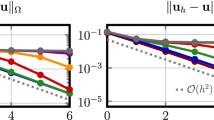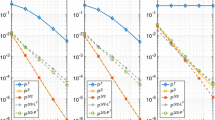Summary
We consider the finite element approximation of the 2D elasticity problem when the Poisson ratiov is close to 0.5. It is well-known that the performance of certain commonly used finite elements deteriorates asv→0, a phenomenon calledlocking. We analyze this phenomenon and characterize the strength of the locking androbustness of varioush-version schemes using triangular and rectangular elements. We prove that thep-andh-p versions are free of locking with respect to the error in the energy norm. A generalization of our theory to the 3D problem is also discussed.
Similar content being viewed by others
References
Arnold, D.N., Falk, R.S. (1987): Well-posedness of the fundamental boundary value problems for constrained anisotropic elastic materials. Arch. Ration. Mech. Anal.98, 143–165
Babuška, I., Suri, M. (1987): Theh-p version of the finite element method with quasiuniform meshes. RAIRO Math. Mod. Numer. Anal.21, 199–238
Babuška, I., Suri, M. (1987): The optimal convergence rate of thep-version of the finite element method. SIAM J. Numer. Anal.24, 750–776
Babuška, I., Suri, M. (1992): On locking and robustness in the finite element method. Tech. Rep. BN-1112, Institute for Physical Science and Technology, University of Maryland, College Park, May 1990. SIAM J. Numer. Anal. (to appear)
Suri, M. (1991): On the robustness of theh-andp-versions of the finite element method. J. Comput. Appl. Math.35, 303–310
de Boor, C. (1990): Private communication
de Boor, C., DeVore, R. (1983): Approximation by smooth multivariate splines. Trans. Amer. Math. Soc.276, 775–788
de Boor, C., Höllig, K. (1983): Approximation order from bivariateC 1 cubics: a counterexample. Proc. Amer. Math. Soc.87, 649–655
de Boor, C., Höllig, K. (1988): Approximation power of smooth bivariatepp functions. Math. Z.197, 343–363
de Boor, C., Jia, R.Q. (1992): A sharp upper bound on the approximation order of smooth bivariatepp functions. J. Approximation Theory (to appear)
Brezzi, F., Fortin, M. (1991): Mixed and Hybrid Finite Element Methods. Springer, Berlin Heidelberg New York
Chui, C.K. (1988): Multivariate Splines. SIAM, Philadelphia
Ciarlet, P.G. (1978): The Finite Element Method for Elliptic Problems. North-Holland, Amsterdam
Fix, G., Strang, G. (1969): Fourier analysis of the finite element method in Ritz-Galerkin theory. Stud. Appl. Math.48, 265–273
Hughes, T.J. (1987): The Finite Element Method, Prentice Hall, Englewood Cliffs, NJ
Jensen, S. (1991): AnH m0 interpolation result. SIAM J. Math. Anal.22, 785–791
Muskhelishvili, N.I. (1963): Some Basic Problems of the Mathematical Theory of Elasticity. Noordhoff, Groningen, The Netherlands
Pinkus, A. (1985): n-widths in Approximation Theory. Springer, Berlin Heidelberg New York
Scott, L.R., Vogelius, M. (1985): Norm estimates for a maximal right inverse of the divergence operator in spaces of piecewise polynomials. RAIRO Math. Modeling Numer. Anal.19, 111–143
Scott, L.R., Vogelius, M. (1985): Conforming finite element methods for incompressible and nearly incompressible continua. In: Large Scale Computations in Fluid Mechanics. Lectures in Applied Mathematics, Vol. 22, Part 2, pp. 221–244. AMS, Providence, RI
Suri, M. (1990): Thep-version of the finite element method for elliptic equations of order2l, RAIRO Math: Modeling Num. Anal.24, 265–304
Sźabo, B.A., Babuška, I. (1991): Finite Element Analysis. Wiley, New York
Vogelius, M. (1983): An analysis of thep-version of the finite element method for nearly incompressible materials. Uniformly valid, optimal error estimates. Numer. Math.41, 19–37
Zenisek, A. (1973): Polynomial approximation on tetrahedrons in the finite element method. J. Approximation Theory7, 334–351
Author information
Authors and Affiliations
Additional information
The work of this author was supported in part by the Office of Naval Research under Naval Research Grant N00014-90-J-1030
The work of this author was supported in part by the Air Force Office of Scientific Research, Air Force Systems Command, U.S. Air Force, under grant AFOSR 89-0252
Rights and permissions
About this article
Cite this article
Babuška, I., Suri, M. Locking effects in the finite element approximation of elasticity problems. Numer. Math. 62, 439–463 (1992). https://doi.org/10.1007/BF01396238
Received:
Issue Date:
DOI: https://doi.org/10.1007/BF01396238




